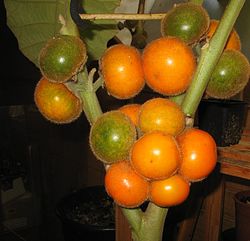Solanum quitoense
| Habit | shrub
| |
|---|---|---|
| Height: | ⇕ | 7 ft"ft" can not be assigned to a declared number type with value 7. |
| Width: | ⇔ | 7 ft"ft" can not be assigned to a declared number type with value 7. |
| Lifespan: | ⌛ | perennial |
| Exposure: | ☼ | sun |
|---|---|---|
| Features: | ✓ | edible, fruit |
| USDA Zones: | 10 to 12 | |
| Flower features: | ❀ | white |
|
Solanum > |
Solanum quitoense, known as naranjilla (Template:IPA-es, "little orange") in Ecuador and as lulo in Colombia, is a subtropical perennial plant from northwestern South America. The scientific name means "nightshade from Quito", and it is indeed a member of the Nightshade family.
The naranjilla plant is attractive, with large heart-shaped leaves up to 45 cm in length. The leaves and stems of the plant are covered in short purple hairs. Naranjilla are delicate plants and must be protected from strong winds and direct sunlight. They grow best in partial shade.
The fruit has a citrus flavour, sometimes described as a combination of rhubarb and lime. The juice of the naranjilla is green and is often used as a drink.
The new growth of this plant is densely covered in protective trichomes. Coloration in the plant's trichomes around the new growth and flowers varies from purple to white. Identification can be difficult for this reason.
Cultivation
Propagation
Pests and diseases
Pests easily destroy a crop of this species. This limits its use for agriculture. One common type of infection is caused by the root-knot nematode. The ripe fruit can be attacked by fungus fairly easily, so it is often picked unripe to avoid rotting.[1]
Varieties
Hybrids are an increasingly popular solution to the nematode pest problem. Solanum quitoense has been hybridized with other plants, most commonly with S. sessiliflorum, a plant with similar phenotypic traits. The leaves, flowers and fruits of S. sessiliflorum are similar in form to S. quitoense, but has much larger fruits that are yellow; the resulting hybrids have fruits with yellowish fruit pulp.[2]
Gallery
References
External links
- w:Solanum quitoense. Some of the material on this page may be from Wikipedia, under the Creative Commons license.
- Solanum quitoense QR Code (Size 50, 100, 200, 500)



